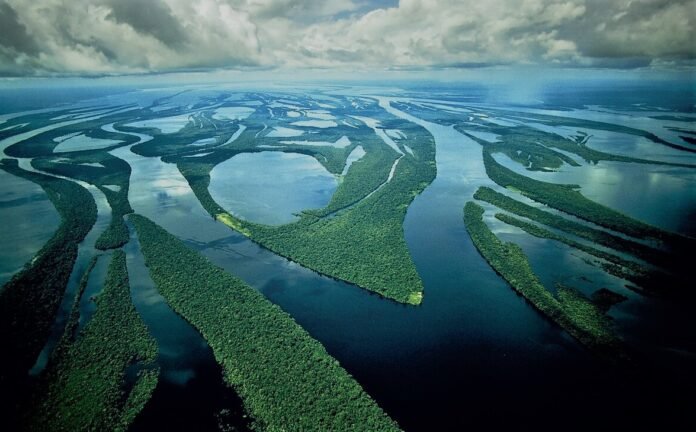The World’s Longest Rivers: A Sojourn Amidst the Earth’s Most Majestic Channels
Rivers – The Planet’s Lifeblood
Rivers, akin to our planet’s arteries, shape the world. They’ve nourished, inspired, and transported innumerable generations. Today, we voyage through the top five longest rivers globally, carving vast landscapes and significantly influencing human civilization.
The Mighty Nile: Africa’s Lifeline (6,650 km)
The Winding Journey to the Mediterranean
Stretching an incredible 6,650 kilometers (4,132 miles), the Nile – the world’s longest river – snakes across northeastern Africa. It springs from the convergence of the White Nile and Blue Nile, traversing Egypt, Sudan, South Sudan, Ethiopia, and Uganda before spilling into the Mediterranean Sea.
The Cradle of Civilization
The Nile – Egypt’s lifeblood for eons – sustained the ancient Egyptian civilization. The river’s fertile banks proffered fresh water, abundant soil, and a robust transportation system, fostering the creation of iconic structures and cultural accomplishments.
The Amazon: A Realm of Biodiversity (6,400 km)
South America’s Verdant Labyrinth
The Amazon River, extending approximately 6,400 kilometers (3,976 miles), is the world’s second-longest river and powers the Amazon Rainforest. Streaming through nine South American nations, the Amazon Basin spans roughly 7 million square kilometers, housing Earth’s most extensive rainforest.
A Trove of Life
The Amazon Rainforest, unparalleled in biodiversity, encompasses around 400 billion individual trees and over 16,000 plant species. More than 3,000 fish species and countless aquatic creatures call the river home, underscoring its critical ecological role.
The Yangtze: China’s Golden Watercourse (6,300 km)
The Dragon’s Backbone
Meandering 6,300 kilometers (3,915 miles) through China’s core, the Yangtze River (Chang Jiang) is the world’s third-longest river and Asia’s longest. This vital transportation and economic lifeline connects multiple industrial and agricultural areas.
A River of Many Faces
The Yangtze originates from the Tibetan Plateau’s glaciers and traverses landscapes from deep gorges to fertile plains. With immense historical and cultural significance, its basin houses an astounding one-third of China’s population. The Three Gorges Dam and the endangered Yangtze River dolphin are among the river’s countless tales.
The Mississippi-Missouri: America’s Great River System (6,275 km)
From the Rockies to the Gulf of Mexico
Stretching 6,275 kilometers (3,902 miles), the Mississippi-Missouri River System is the world’s fourth-longest river and North America’s longest. The Mississippi River springs from Lake Itasca in Minnesota, flowing 3,730 kilometers (2,320 miles) southwards before reaching the Gulf of Mexico.
The Meeting of Two Titans
The Missouri River, the Mississippi’s longest tributary, originates in Montana’s Rocky Mountains and extends 2,341 miles (3,767 km) before merging with the Mississippi near St. Louis, Missouri. Together, they form a vast drainage basin covering roughly 40% of the contiguous United States.
The Backbone of American History
The Mississippi-Missouri River System has been vital to transportation and the economy since early American history. The river system facilitated westward expansion and trade, molding the United States’ growth. The Mississippi River has inspired numerous artists, writers, and musicians, including Mark Twain, who immortalized the river in “The Adventures of Tom Sawyer” and “Adventures of Huckleberry Finn.”
The Yenisei-Angara: Russia’s Mighty Siberian Waterway (5,539 km)
From the Mongolian Plateau to the Arctic Ocean
Measuring 5,539 kilometers (3,442 miles), the Yenisei-Angara River System is the world’s fifth-longest river and Russia’s longest. The river originates in Mongolia, where the Selenga River and the Angara River, springing from Lake Baikal, merge to form the Yenisei River. The river then flows northward through Siberia, slicing across the Central Siberian Plateau before emptying into the Arctic Ocean.
A River of Extremes
The Yenisei River is notorious for its extremes, with sections experiencing temperatures as low as -60°C (-76°F) in winter and as high as 40°C (104°F) in summer. Despite these harsh conditions, the river supports a diverse range of flora and fauna, including the Siberian sturgeon and the critically endangered Siberian crane.
Conclusion: The Unceasing Allure of the World’s Longest Rivers
Our odyssey through the world’s longest rivers has spanned continents and diverse landscapes, highlighting the awe-inspiring power and beauty of these natural marvels. Each river bears a unique history, cultural importance, and ecological significance, illustrating the vital role rivers play in sculpting our world. As we endeavor to preserve and protect these invaluable resources, we’re reminded of the timeless fascination and allure that the world’s longest rivers continue to evoke.
Google News | Telegram
















